PPT 2013 – Motion Paths
The Motion Path tool has the same features – ie. no changes to the type of motion paths or how they are executed. But there is a big change in the editing functionality.
Here is my slide with a Motion Path applied to the car image.
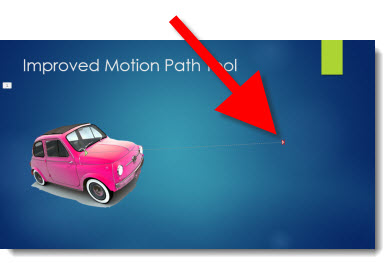
Selecting the object (the car image in this demo) is all the same functionality.
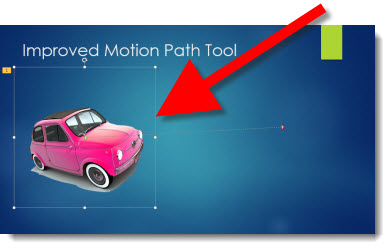
But when the actual Motion Path line is selected (ie. the dotted line), a ghosted (semi-transparent) image in the end position is seen!
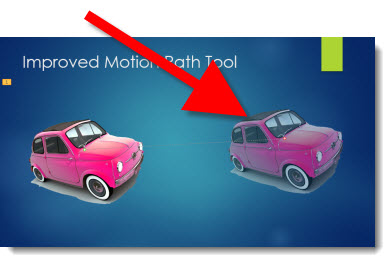
This is a great function addition to this tool.
Note: If you work with Motion Paths, in any version of PPT, I highly recommend the free Motion Path Tools add-in here.
– Troy @ TLC
PPT 2013 – Equidistant with the New Smart Guides
Smart Guides were introduced in PowerPoint 2010 and are a great feature. PowerPoint 2013 has made the good tool even more usable. Smart Guides can now visually show when shapes are equally spaced apart from one another.

This feature is easier to see than explain, so here is a demo showing 6 boxes being aligned and equally spaced (and another great selection of background music).
[youtube src=”https://www.youtube.com/embed/vZmppYSsuhI?rel=0″]
– Troy @ TLC
PPT 2013 – The Eye Dropper is Here!
The Eye Dropper tool is common in virtually all image and graphics programs – but not PowerPoint. An Eye Dropper tool lets you select a color from anything on your screen, without entering a color value (RGB, CMYK, Hex, etc.). It is just a point-click-select-done tool. For many years, I have made great use of the PPTXtreme Color Picker add-in to add the Eye Dropper tool to PowerPoint and it has been invaluable.
PowerPoint 2013 introduces a new Eye Dropper tool!
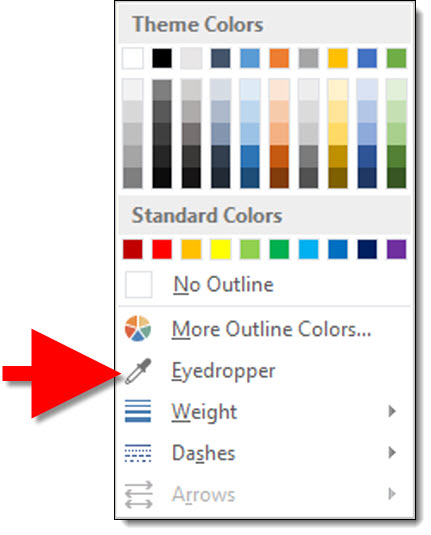
Here is the Eye Dropper in use (and the music is kind of catchy…).
[youtube src=”https://www.youtube.com/embed/14jC_a3jtdk?rel=0″]
– Troy @ TLC
PPT 2013 – New Page Curl Transition!
PPT 2013 has lots of subtle updates and additions. One great addition is a new slide transition – Page Curl.
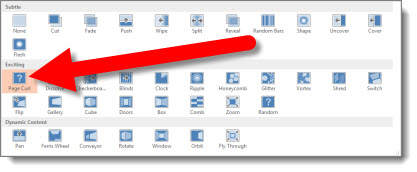
The transition does exactly what its name implies, it visually mimics a book page being turned.
[youtube src=”https://www.youtube.com/embed/TAH85_q8R-U?rel=0″]
There are 4 options: 2 mimic a single large page turning and 2 mimic an open book and one half turning over the other half.
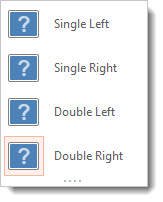
In the Public Beta of PowerPoint 2013, one additional transition is in the options – Random. This transition option disappeared in PPT 2007, so it is not really new.
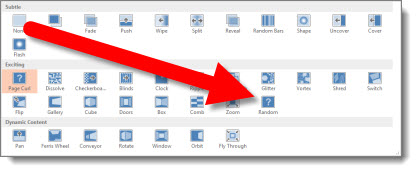
I am guessing (hoping) more exciting options will be in the full release (time will tell).
– Troy @ TLC
PPT 2013 – New Format Picure Dialog
Here is the familiar Format Picture dialog from PPT 2010:
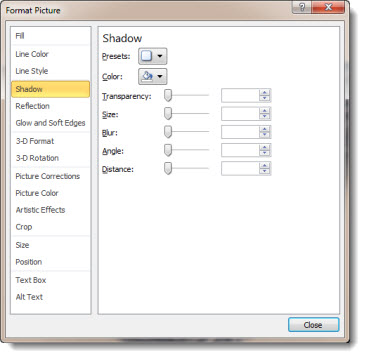
In PPT 2013, the tools options and features remain the same, but the dialog gets a remake. The Format Picture ribbon shows the Metro icons:

Opening the Format Picture dialog opens a new pane on the right:
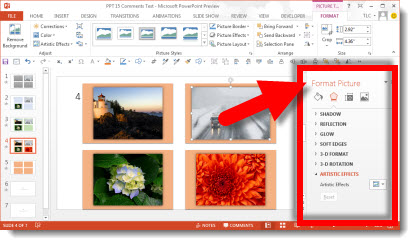
This new single pane is where all of the formatting options are accessed:
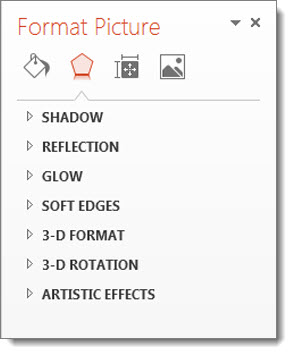
Select a tool and the dialog box extends to show the formatting options.
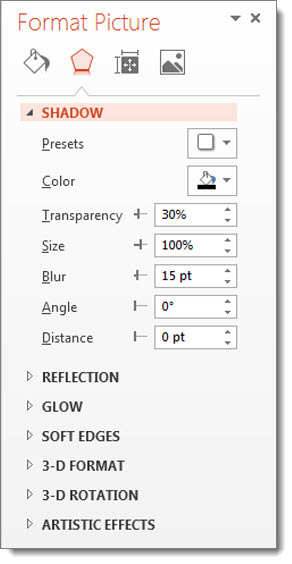
Select another tool and the box continues to extend and reveal those formatting options.
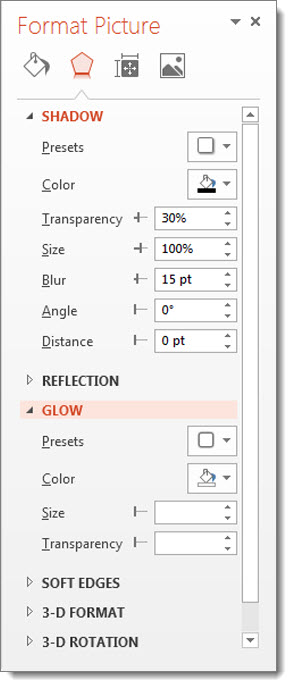
In addition, the Format Dialog pane can be detached from the UI and become a free floating dialog box. When floating, the same expanding list and organization of tools is seen. The floating dialog is not bound to the application window and can be positioned on a second monitor.
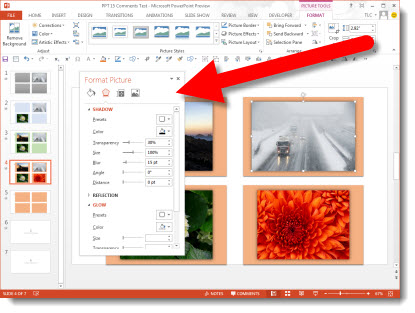
Using the icons across the top of the Format Dialog brings up the options for:
– Fill and line
– Effects
– Size and properties
– Picture
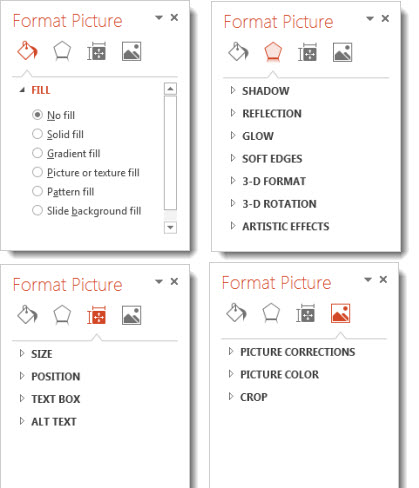
– Troy @ TLC
Office 13 App Icons
Every version of Office has its own variation of the application icons. Here is a quick history:
Office 2003 used square “chiclet” icons:
Office 2007 used alpha transparency for unique, non-square, icons and added gradients throughout:
Office 2010 used the solid square of 2003, filled with the icons and gradients of 2007, and added uniform identifying letters for each app (despite the full application suite had 3 “P” icons):
Office 2013 has both a solid square version and a alpha transparency version. The icons are developed direct from the Microsoft Metro style guide, which is simplified icons, but retaining the identifying letters (and yes, still 3 P’s):
When PowerPoint 2013 is launched, one of the immediate reactions is the orange bars and accents in the UI. One of the constants for Office is each application has an identifying color. Looking through the generations of icons, PowerPoint is orange, Word is blue, Excel is green, OneNote is purple, etc. So by the luck of history, the most visual application, PowerPoint, has one of the most offending/conflicting/glaring colors associated with it… I can say, based on the early builds of PowerPoint I looked at, the UI could have been much more distracting.
– Troy @ TLC
PPT 2013 – Updated Ribbon “Metro” UI
When you first launch PowerPoint 2013, it looks similar and different at the same time.

If you look at the ribbon, everything is in the now familiar locations and order.
When viewed more closely, you can see all of the aesthetics are new – in the “Metro” style. The Metro style was developed by Microsoft for the Windows Phone 7 interface. It is a success and has now become the basis for the Windows 8 UI and the Office 2013 UI, plus the MS website and many other interfaces.
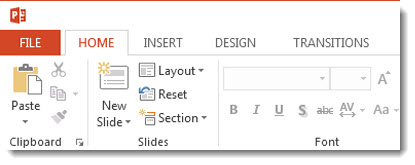
Ironically, one of the original design reasons for Metro was “a key design principle of Metro is better focus on the content of applications, relying more on typography and less on graphics.” But, PowerPoint’s interface is definitely icon oriented and where typography is used, it has mixed reviews (ie. all caps for the ribbon tabs).
Also new is the logged in user option (for my Beta install the user is “TLC”). There is a lot of new features around the user account, which are overviewed in upcoming posts.
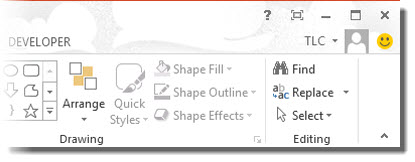
The happy face icon on the far right is a standard feature of Microsoft beta software. Clicking it brings up a dialog box to submit feedback, bug reports, etc. you discover while using the application. The smiley will not be a part of the retail version.
While the new aesthetics are not going to be everyone’s favorite, they are what is coming to a computer near you.
– Troy @ TLC
